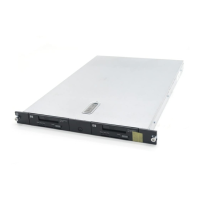9. Use vgdisplay –v to verify that the volume group was created correctly. The –v option
displays the detailed volume group information.
Example
# vgdisplay –v /dev/vg06
- - - Volume groups - - -
VG Name /dev/vg06
VG Write Access read/write
VG Status available
Max LV 255
Cur LV 0
Open LV 0
Max PV 16
Cur PV 1
Act PV 1
Max PE per PV 1016
VGDA 2
PE Size (Mbytes) 4
Total PE 586
Alloc PE 0
Free PE 586
Total PVG 0
- - Physical Volumes - - -
PV Name /dev/dsk/c6t0d0
PV Status available
Total PE 586
Free PE 586
Creating logical volumes
Use these commands for logical volume configuration:
• lvremove
Deletes a logical volume. Any file system attached to the logical volume must be unmounted
before executing the lvremove command.
Example
lvremove /dev/vgnn/lvolx
• lvextend
Increases the size of an existing logical volume.
Example
lvextend –L size /dev/vgnn/lvolx
• lvreduce
Decreases the size of an existing logical volume. Any file system attached to the logical volume
must be unmounted before executing the lvreduce command.
Example
lvreduce –L size /dev/vgnn/lvolx
CAUTION: Data within the file system can be lost after execution of lvreduce.
Create logical volumes after you create volume groups. A logical volume must be created for each
new SCSI disk device.
24 HP-UX

